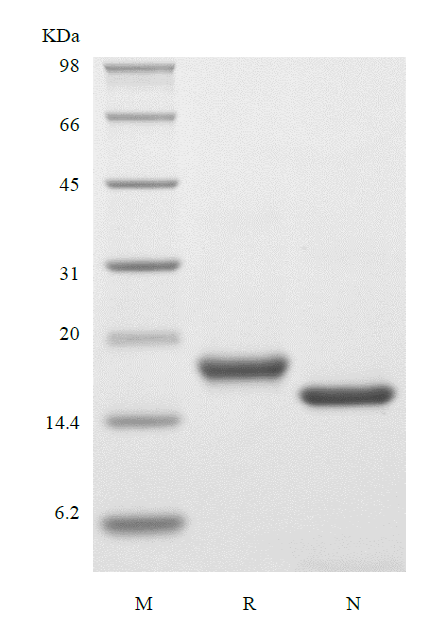- Synonyms
- LP-1, pre-B cell factor
- Source
- Escherichia coli
- Molecular Weight
- Approximately 17.4 kDa, a single non-glycosylated polypeptide chain containing 152 amino acids.
- Size
- 10 µg/100 µg/500 µg/1 mg
- Sequence
- DCDIEGKDGK QYESVLMVSI DQLLDSMKEI GSNCLNNEFN FFKRHICDAN KEGMFLFRAA RKLRQFLKMN STGDFDLHLL KVSEGTTILL NCTGQVKGRK PAALGEAQPT KSLEENKSLK EQKKLNDLCF LKRLLQEIKT CWNKILMGTK EH
- Purity
- > 97% by SDS-PAGE and HPLC analyses.
- Biological Activity
- Fully biologically active when compared to standard. rHuIL-7 stimulates proliferation of PHA-activated human peripheral blood mononuclear cell (PBMC). The specific activity of Recombinant Human IL-7 is > 1.0 × 108 Units/mg, which is calibrated against human IL-7 WHO Standard (NIBSC code: 90/530).
- Physical Appearance
- Sterile Filtered White lyophilized (freeze-dried) powder.
- Formulation
- Lyophilized from a 0.2 µm filtered concentrated solution in 20 mM PB, 150 mM NaCl, pH 7.4.
- Endotoxin
- Less than 1 EU/µg of rHuIL-7 as determined by LAL method.
- Reconstitution
- Prior to opening, it is recommended to centrifuge the vial briefly to bring the contents down the bottom. Reconstitute in sterile distilled water or aqueous buffer containing 0.1% BSA to a concentration of 0.1-1.0 mg/ml. If animal-origin-free condition is expected in your product, then sterile distilled water is recommended. Stock solutions should be apportioned into working aliquots and stored at ≤ -20 °C. Further dilutions should be made in appropriate buffered solutions.
- Shipping
- The product is shipped with polar packs. Upon receipt, store it immediately at the temperature recommended below.
- Stability & Storage
- Use a manual defrost freezer and avoid repeated freeze-thaw cycles.
- A minimum of 12 months from date of receipt, when stored at ≤ -20 °C as supplied.
- 1 month, 2 to 8 °C under sterile conditions after reconstitution.
- 3 months, -20 to -70 °C under sterile conditions after reconstitution.
- Usage
- This material is offered by Shanghai PrimeGene Bio-Tech for research, laboratory or further evaluation purposes. NOT FOR HUMAN USE.
- SDS-PAGE

- Reference
- 1. Goodwin RG, Lupton S, Schmierer A, et al. 1989. Proc Natl Acad Sci U S A. 86:302-6.
2. Sutherland GR, Baker E, Fernandez KE, et al. 1989. Hum Genet. 82:371-2.
3. Lupton SD, Gimpel S, Jerzy R, et al. 1990. J Immunol. 144:3592-601.
4. Noguchi M, Nakamura Y, Russell SM, et al. 1993. Science. 262:1877-80.
5. Fry TJ, Mackall CL. 2002. Blood. 99:3892-904.
6. Fry TJ, Mackall CL. 2002. J Hematother Stem Cell Res. 11:803-7.
- Background
- Interleukin-7 (IL-7) is encoded by the IL7 gene and secreted by stromal cells in the red marrow and thymus. It binds to the IL-7 receptor, a heterodimer consisting of IL-7 receptor alpha and IL-2 receptor gamma chain. IL-7 stimulates the differentiation of hematopoietic stem cells into lymphoid progenitor cells and also stimulates proliferation of B cells, T cells and NK cells. Murine IL-7 has approximately 65% amino acid sequence identity with human IL-7 and both proteins exhibit cross-species activity. IL-7 as an immunotherapy agent has been examined in many human clinical trials for various malignancies and during HIV infection.

 COA申请
COA申请
